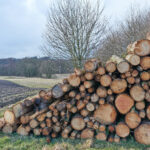The perennial trade dispute between the United States and Canada over softwood lumber has reignited with a fresh wave of controversy. The United States Department of Commerce's recent announcement of its preliminary determination in the sixth annual review of Canadian softwood lumber imports for the calendar year 2023 has triggered a fierce war of words across the border. The proposed anti-subsidy rate of 14.38% and a combined preliminary anti-subsidy and anti-dumping duty rate of 34.45% have been met with outrage in Canada and warnings of increased housing costs in the U.S., setting the stage for yet another chapter in this decades-long saga.
The Latest Salvo: Commerce Department's Tariff Plan
On April 4, 2025, the U.S. Department of Commerce revealed its preliminary findings, suggesting a significant hike in tariffs on Canadian softwood lumber. This decision, a result of the annual review process, concluded that Canadian lumber imports in 2023 benefited from unfair subsidies and were being dumped into the U.S. market at unfairly low prices. The proposed combined duty rate of 34.45% marks a substantial increase from previous levels and has been lauded by the U.S. Lumber Coalition as a necessary measure to address "egregious harm" to the domestic industry caused by Canada's "abusive dumping and subsidies practices."
Andrew Miller, owner/chair of Stimson Lumber Company and Chairman of the U.S. Lumber Coalition, stated that these unfair trade practices were designed to give Canadian producers an "artificially inflated U.S. market share," forcing American companies to reduce production and costing U.S. jobs. This rhetoric echoes the long-standing argument of the U.S. lumber industry, which contends that the Canadian forestry system, where most timber is harvested from Crown land with stumpage fees set by provincial governments, constitutes an unfair subsidy compared to the U.S. system of private land and auction-based pricing.
Canadian Fury and the Threat to Housing Affordability
Across the border, the reaction to the Commerce Department's announcement has been one of strong condemnation. Canadian politicians and industry leaders have decried the proposed tariffs as unjustified, punitive, and detrimental to both Canadian workers and American consumers.
David Eby, the Premier of British Columbia, the largest Canadian exporter of softwood lumber to the U.S., minced no words in his response. He argued that the "double countervailing duties" would inevitably drive up housing costs for Americans, directly contradicting promises made to lower these costs. Eby emphasized the challenges already facing British Columbia's forestry sector and vowed to stand with "Team Canada" to respond strongly if the tariffs are imposed. He further asserted that all duties on softwood lumber are unjustified and based on biased calculations.
Ontario's Minister of Natural Resources and Forestry, and the province's Minister of Northern Development, echoed these sentiments, expressing deep disappointment with the U.S.'s intention to drastically raise duty rates. They warned that these "unjustified and punitive measures" would increase construction costs and further strain housing affordability for American families, harming jobs and economic growth on both sides of the border. Their joint statement affirmed Ontario's firm stance that these duties should be lifted entirely.
The Canadian government has consistently refuted the U.S. claims of unfair subsidies, arguing that their forestry practices are sustainable and market-based. They point to the integrated nature of the North American lumber market and the crucial role Canadian lumber plays in meeting U.S. housing demand.
The Historical Context: A Decades-Long Dispute
The softwood lumber dispute between Canada and the U.S. is one of the most enduring trade irritants between the two nations, dating back to 1982. The core of the disagreement lies in the differing approaches to timber harvesting and pricing. In Canada, provincial governments own the majority of forest resources and administer stumpage rates (fees paid by logging companies to harvest timber). The U.S. lumber industry has long argued that these stumpage rates are set artificially low, providing Canadian producers with an unfair competitive advantage. In contrast, in the U.S., timber is primarily harvested from private land, and prices are determined through market auctions.
Over the past four decades, this dispute has cycled through numerous investigations, negotiations, agreements, and legal challenges under both domestic laws and international trade bodies like the World Trade Organization (WTO) and the North American Free Trade Agreement (NAFTA) (now the USMCA). While temporary agreements have been reached, they have often been followed by renewed conflict upon expiry or allegations of non-compliance.
The 2006 Softwood Lumber Agreement, which managed trade for nine years before expiring in 2015, represented a period of relative stability. However, since its expiry, the U.S. has reimposed tariffs, leading to ongoing legal battles and trade tensions. Canada has, in the past, successfully challenged U.S. trade actions under international dispute resolution mechanisms, highlighting the contentious nature of this issue.
The Impact on the U.S. Housing Market
The potential impact of increased softwood lumber tariffs on the U.S. housing market is a significant concern. The National Association of Home Builders (NAHB) has consistently warned that tariffs on Canadian lumber, a crucial input for American homebuilders, drive up construction costs and exacerbate the housing affordability crisis.
According to the NAHB, tariffs already in place have added thousands of dollars to the cost of building an average new home. The proposed doubling of duties could further inflate these costs, potentially leading to higher home prices for consumers at a time when affordability is already a major challenge.
Industry experts argue that the U.S. domestic lumber industry does not have the capacity to fully meet the country's demand for softwood lumber. Canada remains a vital supplier, accounting for a significant portion of U.S. lumber imports. Restricting these imports through high tariffs could lead to supply shortages and price volatility, echoing the lumber price spikes seen during the COVID-19 pandemic.
The exemption of Canadian lumber from President Trump's recent "reciprocal tariffs" was initially seen as a positive development for the housing market. However, the Commerce Department's separate announcement of increased anti-subsidy and anti-dumping duties has negated this relief, sending homebuilder stocks plunging and raising fears of a further pullback in the housing sector.
Arguments For and Against Tariffs
The debate over softwood lumber tariffs involves complex economic and political considerations, with valid arguments on both sides:
Arguments for Tariffs (Primarily from the U.S. Lumber Coalition):
- Addressing Unfair Subsidies: The core argument is that Canadian stumpage fees constitute an unfair subsidy, allowing Canadian producers to sell lumber at artificially low prices and harming the U.S. industry.
- Protecting Domestic Jobs: Tariffs are seen as a way to protect American lumber jobs and ensure the viability of the domestic industry.
- Leveling the Playing Field: Proponents argue that tariffs are necessary to create a level playing field between U.S. and Canadian producers with different cost structures.
- Ensuring Domestic Supply: While currently debated, some argue that tariffs can incentivize domestic production and reduce reliance on imports.
Arguments Against Tariffs (Primarily from Canadian Producers and U.S. Homebuilders/Consumers):
- Increased Housing Costs: The most significant counter-argument is that tariffs directly increase the cost of lumber, making housing less affordable for American families.
- Disruption of Supply Chains: Tariffs can disrupt the integrated North American lumber supply chain, leading to shortages and price volatility.
- Harm to Consumers: Higher lumber prices ultimately translate to higher costs for consumers, whether they are buying new homes or undertaking renovations.
- Retaliatory Measures: Tariffs can provoke retaliatory actions from Canada, harming other sectors of the U.S. economy.
- Limited Impact on Domestic Production: Critics argue that U.S. domestic production alone cannot meet demand, making Canadian imports essential.
- Questionable Basis of Subsidies Claim: Canada argues that its forestry practices are sustainable and market-based, and that stumpage fees reflect market conditions and forest management costs.
The Path Forward: Uncertainty and Potential Negotiations
The immediate future of the softwood lumber dispute remains uncertain. The U.S. Department of Commerce's preliminary determination will undergo further review, and a final decision is expected later in the year. During this time, both sides will likely continue their war of words and explore potential avenues for resolution.
The Canadian government has indicated its intention to vigorously fight the tariffs, potentially through further legal challenges under the USMCA or other international trade mechanisms. Simultaneously, there may be pressure for renewed bilateral negotiations to find a long-term solution to this persistent trade irritant.
For businesses and consumers in both countries, the ongoing uncertainty is a cause for concern. Lumber prices are likely to remain volatile, impacting construction costs and potentially slowing down housing development in the U.S. Canadian lumber producers face the prospect of higher duties, which could affect their competitiveness in the crucial U.S. market.
The outcome of this latest chapter in the softwood lumber saga will have significant implications for the North American economy, particularly the housing sector. Whether it leads to a renewed cycle of litigation and trade friction or sparks meaningful negotiations towards a lasting agreement remains to be seen. However, the current war of words underscores the deep-seated disagreements that continue to plague this critical trade relationship.












